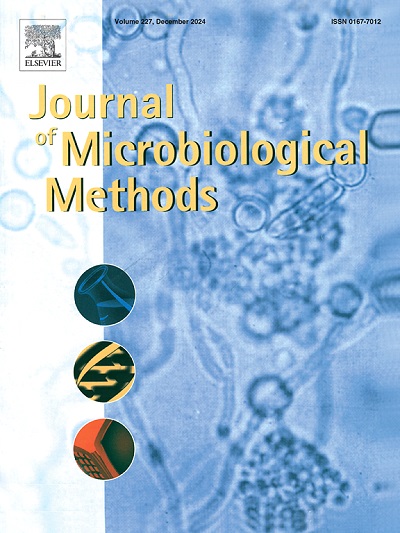Fermentation dynamics of bile salt hydrolase production in Heyndrickxia coagulans ATCC 7050 and Lactiplantibacillus plantarum ATCC 10012: Addressing ninhydrin assay limitations with a novel HPTLC–MS method
IF 1.9
4区 生物学
Q4 BIOCHEMICAL RESEARCH METHODS
引用次数: 0
Abstract
Bile salt hydrolase (BSH), a pivotal enzyme in cholesterol management, holds significant promise in both human and animal subjects. This study investigated the effect of fermentation dynamics in Heyndrickxia coagulans ATCC 7050 and Lactiplantibacillus plantarum ATCC 10012 to enhance BSH production. Cultivation of cultures in MRS and M17 media revealed that MRS medium enhanced BSH production by 235.98 % in H. coagulans ATCC 7050 and 147.37 % in L. plantarum ATCC 10012, compared to M 17 medium. Additionally, varying oxygen concentration levels indicated that H. coagulans ATCC 7050 exhibited its minimum doubling time of 79.8 ± 0.64 min in anaerobic conditions, whereas L. plantarum ATCC 10012 demonstrated its minimum doubling time of 85.5 ± 1.2 min under microaerophilic conditions. However, their highest BSH activity was observed during the stationary phase under anaerobic conditions, yielding 17.14 ± 0.78 U/mL by H. coagulans ATCC 7050 and 19.04 ± 0.81 U/mL by L. plantarum ATCC 10012. Furthermore, it was observed that both organisms did not retain BSH within their cells. BSH activity was assessed using ninhydrin assay that detected free taurine liberated from sodium taurocholate. However, ninhydrin can yield false–positive results owing to its interaction with other free amino acids. To subjugate this limitation, the study introduced a novel and sensitive HPTLC–MS method capable of accurately detecting taurine. By comprehending fermentation dynamics and selecting appropriate conditions, BSH production increased 2.1–fold in both organisms. These findings illuminate critical insights, offering a pathway for novel strategies to enhance the BSH–producing capabilities of these LAB strains.
Heyndrickxia coagulans ATCC 7050 和 Lactiplantibacillus plantarum ATCC 10012 产生胆盐水解酶的发酵动力学:用新型 HPTLC-MS 方法解决茚三酮测定的局限性。
胆盐水解酶(BSH)是控制胆固醇的关键酶,在人类和动物实验中都大有可为。本研究调查了 Heyndrickxia coagulans ATCC 7050 和 Lactiplantibacillus plantarum ATCC 10012 的发酵动力学对提高 BSH 产量的影响。在 MRS 和 M17 培养基中培养的结果表明,与 M 17 培养基相比,MRS 培养基可使凝结球菌 ATCC 7050 和植物乳杆菌 ATCC 10012 的 BSH 产量分别提高 235.98% 和 147.37%。此外,不同的氧气浓度水平表明,凝结球菌 ATCC 7050 在厌氧条件下的最短倍增时间为 79.8 ± 0.64 分钟,而植物杆菌 ATCC 10012 在微嗜氧条件下的最短倍增时间为 85.5 ± 1.2 分钟。然而,在厌氧条件下,它们在静止期的 BSH 活性最高,H. coagulans ATCC 7050 为 17.14 ± 0.78 U/mL,L. plantarum ATCC 10012 为 19.04 ± 0.81 U/mL。此外,还发现这两种生物的细胞内都没有保留 BSH。BSH 活性是通过茚三酮检测法评估的,该方法可检测从牛磺胆酸钠中释放出的游离牛磺酸。然而,由于茚三酮与其他游离氨基酸相互作用,可能会产生假阳性结果。为了克服这一局限性,该研究引入了一种新颖灵敏的 HPTLC-MS 方法,能够准确检测牛磺酸。通过了解发酵动态和选择适当的条件,两种生物的 BSH 产量都提高了 2.1 倍。这些发现阐明了关键的见解,为提高这些 LAB 菌株的 BSH 生产能力的新策略提供了途径。
本文章由计算机程序翻译,如有差异,请以英文原文为准。
求助全文
约1分钟内获得全文
求助全文
来源期刊

Journal of microbiological methods
生物-生化研究方法
CiteScore
4.30
自引率
4.50%
发文量
151
审稿时长
29 days
期刊介绍:
The Journal of Microbiological Methods publishes scholarly and original articles, notes and review articles. These articles must include novel and/or state-of-the-art methods, or significant improvements to existing methods. Novel and innovative applications of current methods that are validated and useful will also be published. JMM strives for scholarship, innovation and excellence. This demands scientific rigour, the best available methods and technologies, correctly replicated experiments/tests, the inclusion of proper controls, calibrations, and the correct statistical analysis. The presentation of the data must support the interpretation of the method/approach.
All aspects of microbiology are covered, except virology. These include agricultural microbiology, applied and environmental microbiology, bioassays, bioinformatics, biotechnology, biochemical microbiology, clinical microbiology, diagnostics, food monitoring and quality control microbiology, microbial genetics and genomics, geomicrobiology, microbiome methods regardless of habitat, high through-put sequencing methods and analysis, microbial pathogenesis and host responses, metabolomics, metagenomics, metaproteomics, microbial ecology and diversity, microbial physiology, microbial ultra-structure, microscopic and imaging methods, molecular microbiology, mycology, novel mathematical microbiology and modelling, parasitology, plant-microbe interactions, protein markers/profiles, proteomics, pyrosequencing, public health microbiology, radioisotopes applied to microbiology, robotics applied to microbiological methods,rumen microbiology, microbiological methods for space missions and extreme environments, sampling methods and samplers, soil and sediment microbiology, transcriptomics, veterinary microbiology, sero-diagnostics and typing/identification.
 求助内容:
求助内容: 应助结果提醒方式:
应助结果提醒方式:


